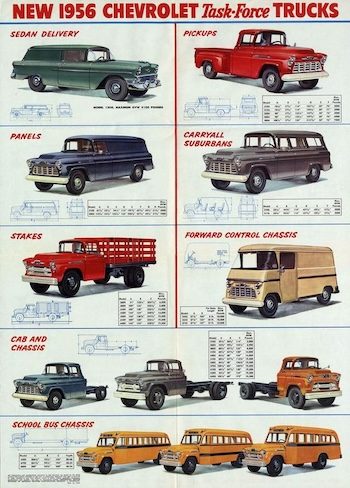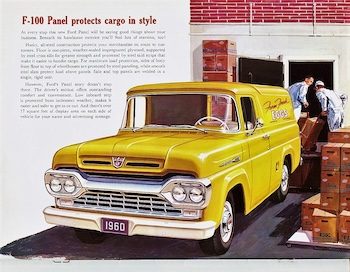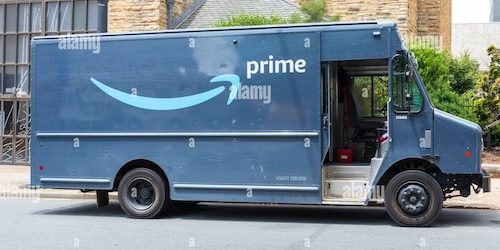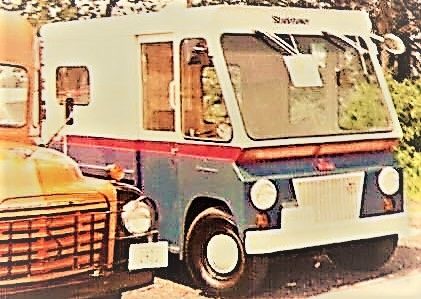By Greg Zyla —
This week, we’re back looking at the evolution of the delivery van, which here in 2025 has changed dramatically from the way things were back in the 1950s through the 1980s. The popularity of online shopping is the main reason for the demise of the shopping malls, as most everyone who reads this column can relate to the boom of Amazon Prime delivery vans and the closing of numerous malls and brick and mortar stores near their homes.
These company-specific Amazon Prime vans join with the other delivery services, most notably USPS and UPS, all of which are finished in company livery colors. Furthermore, the more consumers order online, the more we’ll undergo the demise of the malls and brick-and-mortar stores that were once community centers of activity.
Unfortunately, it’s a distressing end for malls. Once our beloved gathering places for everything from movies, diners, site-specific stores, shopping, and, most importantly, camaraderie, today most are closed. Bottom line? You can’t stop the power of ordering online and having a product sitting on your doorstep in a day or two.

Amazon Prime uses the Ford Transit and Ram ProMaster as its top choices to deliver its products to customers. Notable is Amazon utilizing 20,000 Rivian electric delivery vans with hopes of this number increasing to 100,000 electric vans by 2030. (Amazon)
While it’s difficult to pinpoint the exact number of malls that have closed solely due to online shopping, it’s clear that many have closed or are struggling to stay afloat.
For example, major retailers like JC Penney, Macy’s, Kmart, and Sears have closed numerous stores across the country. Moneywise.com notes that in 2024 alone, retail closures reached their highest level since the pandemic, with 7,325 locations shuttering. It’s projected that 15,000 stores will close by the end of 2025.
Hopefully, malls these days are incorporating more entertainment venues to attract consumers as the movie theaters are still a major attraction, and while just about every mall that has survived features large gyms that are thriving.
Back to the delivery trucks I loved as a child.
Things were different yesteryear when deliveries like the milkman or a Charles Chip truck are still top of mind in my nostalgia-laced brain. Small and large companies had colorful delivery trucks. Sure, there was limited mail order around, like Sears & Roebuck, but in person trips for shopping were still the first choice.

The 1956 Chevrolet Task Force Truck advertisement explains its truck models in detail, from sedan delivery to school bus. (Chevrolet)
Further, in addition to the Prime delivery vans I see going up and down my street, I recently noticed what I thought was a food delivery service in my driveway like Uber Eats, DoorDash, Postmates, Grubhub, and Toast Takeout, but it turned out to be an independent Amazon delivery driver using her own SUV instead of the larger Prime Amazon grey-colored van. This realization means Amazon is growing to now include independent drivers like Uber and DoorDash.
As for Amazon’s Prime delivery vans, Amazon uses the Ford Transit and Ram ProMaster as its top choices for delivery, but notable is Amazon utilizing 20,000 Rivian electric delivery vans with hopes of this number increasing to 100,000 electric vans by 2030. Thankfully, the Biden administration issued a 12th hour $6.57 million loan from the Department of Energy to keep Rivian afloat and assist in Rivian’s stalled Georgia EV assembly plant.
As we step into the “Zyla Time Machine,” I again dial back to 1955 and my very first experience with a delivery van. Specifically, I remember watching my dad hand-letter a new 1955 Chevy Panel Delivery Wagon for a local business located in Ranshaw, Pa. The car/truck was black with shiny hubcaps, and my dad used a high-gloss yellow paint to letter the company name, notably Ned Stank Furniture & Appliances, along with Ned’s address and phone number on the side and doors. I was five years old at the time.

Ford’s 1960 F-100 series delivery truck was a bestseller and used by many companies for deliveries. (Ford)
With this vivid memory still playing in my mind, I’m sure we agree that here in 2025 the popularity of all types of collectible trucks is growing. This fact is proven by the money these early-day vehicles generate at Mecum and Barrett-Jackson auctions. Even stripped-down pickups, known as farm trucks, are commanding $30,000 and up in great, restored condition.
As for the collector’s love of panel trucks from 1957 to 1960, the most popular back then were the Chevy/GMC and Ford varieties, with Dodge, International, and Studebaker’s USPS Zipvan also notable. These panel and smaller delivery trucks were extremely popular because, back then, the smaller vans that would eventually replace the car-like delivery panels were just starting to arrive on the scene. From Tastykake to meat delivery trucks, the streets were wide-open advertising venues for the hundreds of companies that understood the importance of a rolling billboard.
And, just as the full-size delivery vans that were then the number one choice of many companies (like the 1960 F-100 Series Fords), they would also share some lighter duty hauling with the smaller, car-like station wagon sedan delivery units that popped up quickly. In 1960, even the new compact Ford Falcon delivery panel joined the fray while competing Corvair offered a van and pickup truck, both rear engine vehicles.
Not surprisingly, these panel delivery trucks, from full size to compact, were similar in that they were built with no seating other than the driver and in some instances a passenger seat. Likewise, the station wagons were quickly turned into delivery wagons by removing the side windows and rear seating. By the early 1970s, even the Chevy Vega and Ford Pinto offered panel wagons that to this day are popular, lower cost entries into the world of collectible trucks.

Back in 2020, Amazon utilized the older-style step van, reminiscent of the step vans from the 1960s. (Amazon)
Next arrived the now defunct Chevrolet HHR (high heritage roof) and Chrysler PT Cruiser conversions, which were both created by noted car designer Bryan Nesbitt. These little car/wagons became instant hits when retrofitted in sedan delivery livery and were used by countless companies for light duty deliveries.
Additionally, the original delivery panel trucks I’ve mentioned in my columns since back in 1974 did have competition. Chevy, Ford and Willys come quickly to mind. However, unlike the light duty Metro, I remember the heavy-duty Ford Delivery trucks that came in P350 to P600 series builds with dual rear wheels for heavier load potential.
The 1956 Chevrolet Task Force Truck advertisement best exemplifies how the major manufacturers promoted their truck line. Everything from light duty panels to the bigger delivery trucks are clearly explained in detail including haul abilities and cargo information.
In summary, sedan deliveries and delivery panel trucks came in all shapes and sizes, from the converted station wagons to the big bruisers from Chevy, Dodge, and Ford that were common sights on our nation’s highways. Unfortunately, you just don’t see that many anymore these days.
(Greg Zyla is a syndicated auto columnist who welcomes reader interaction on auto nostalgia, collector cars, or motorsports at greg@gregzyla.com or at 303 Roosevelt St., Sayre, Pa. 18840.)



Be the first to comment on "Collector Car/ Cars We Remember; More delivery trucks, less shopping malls"